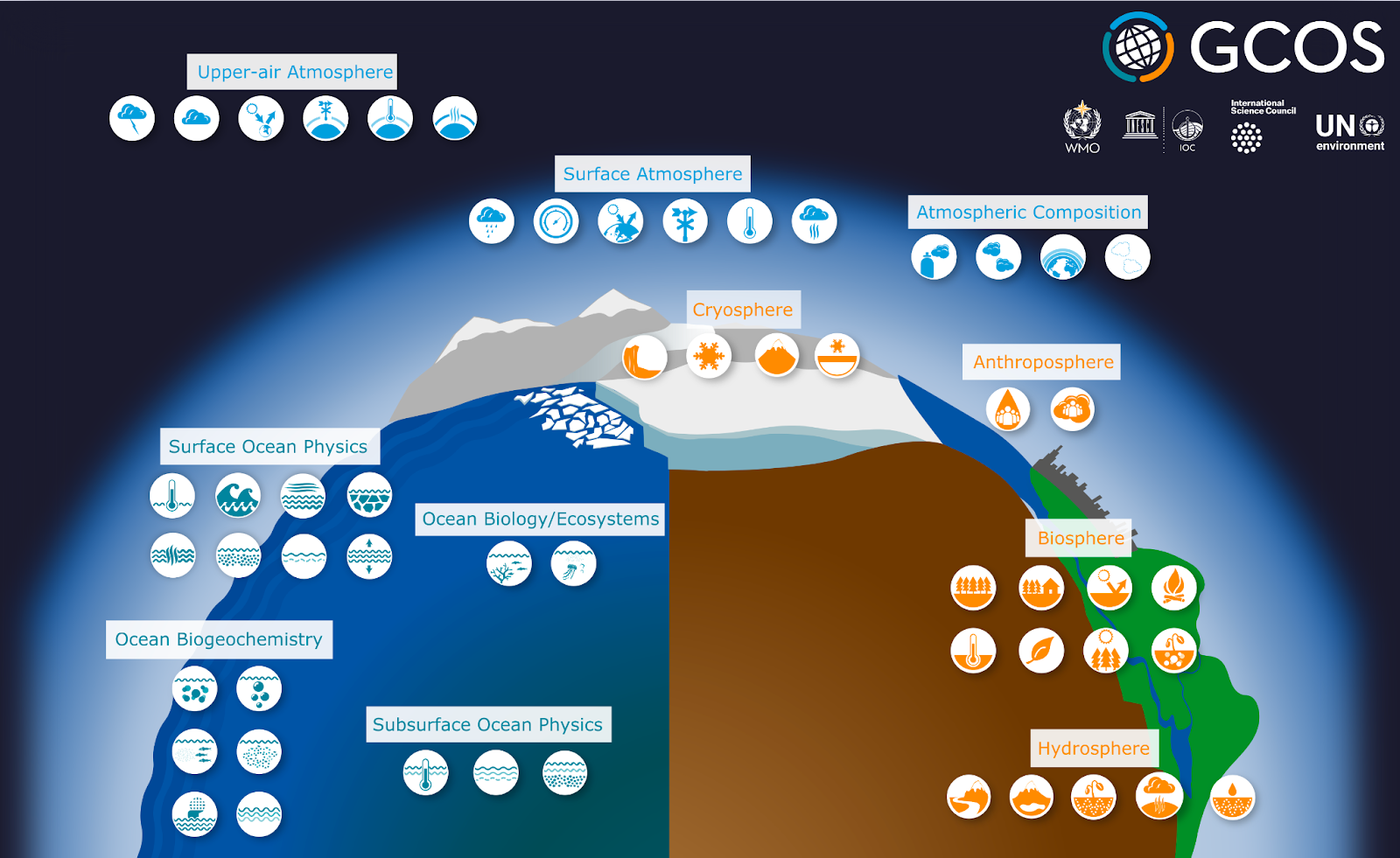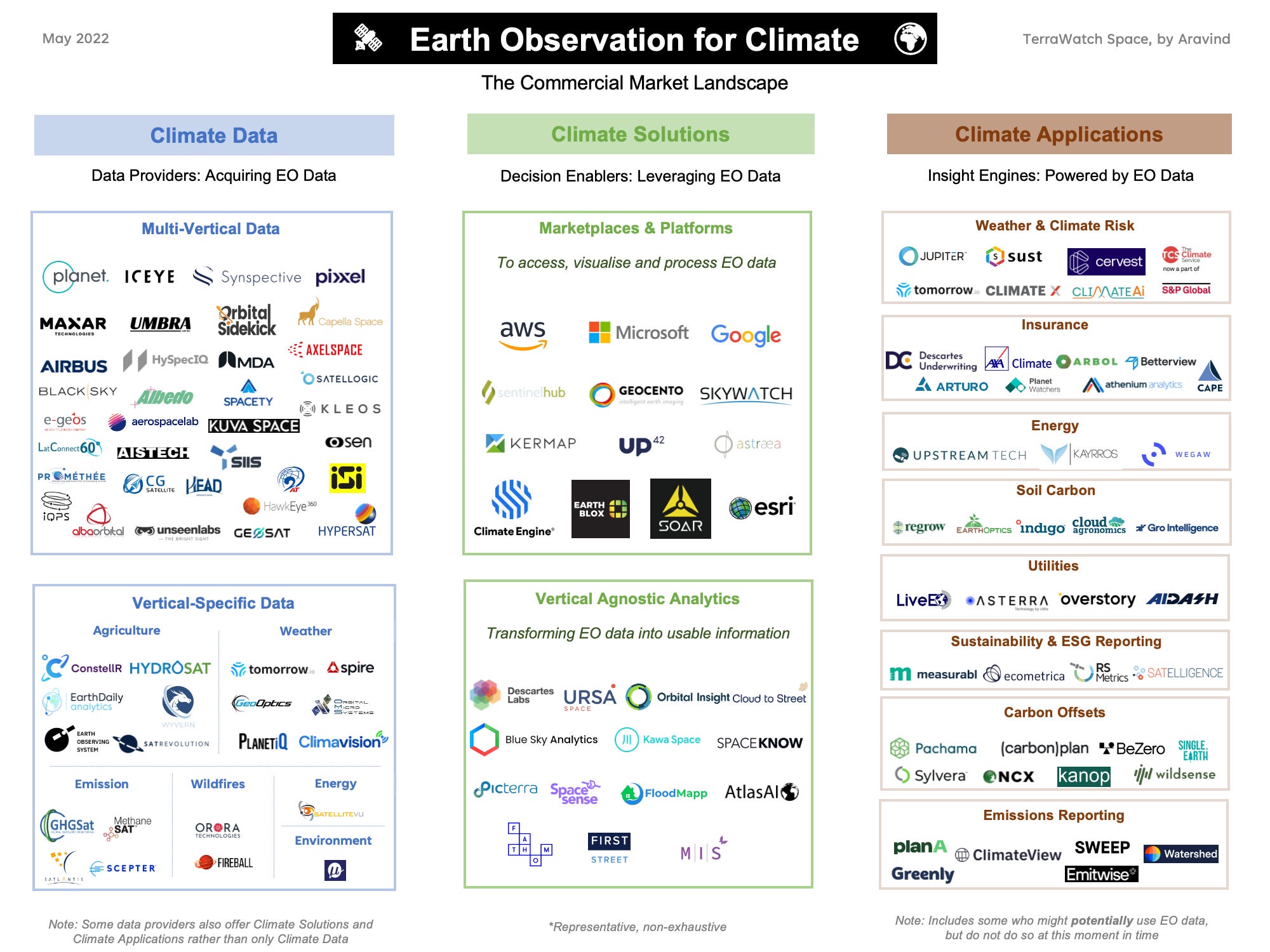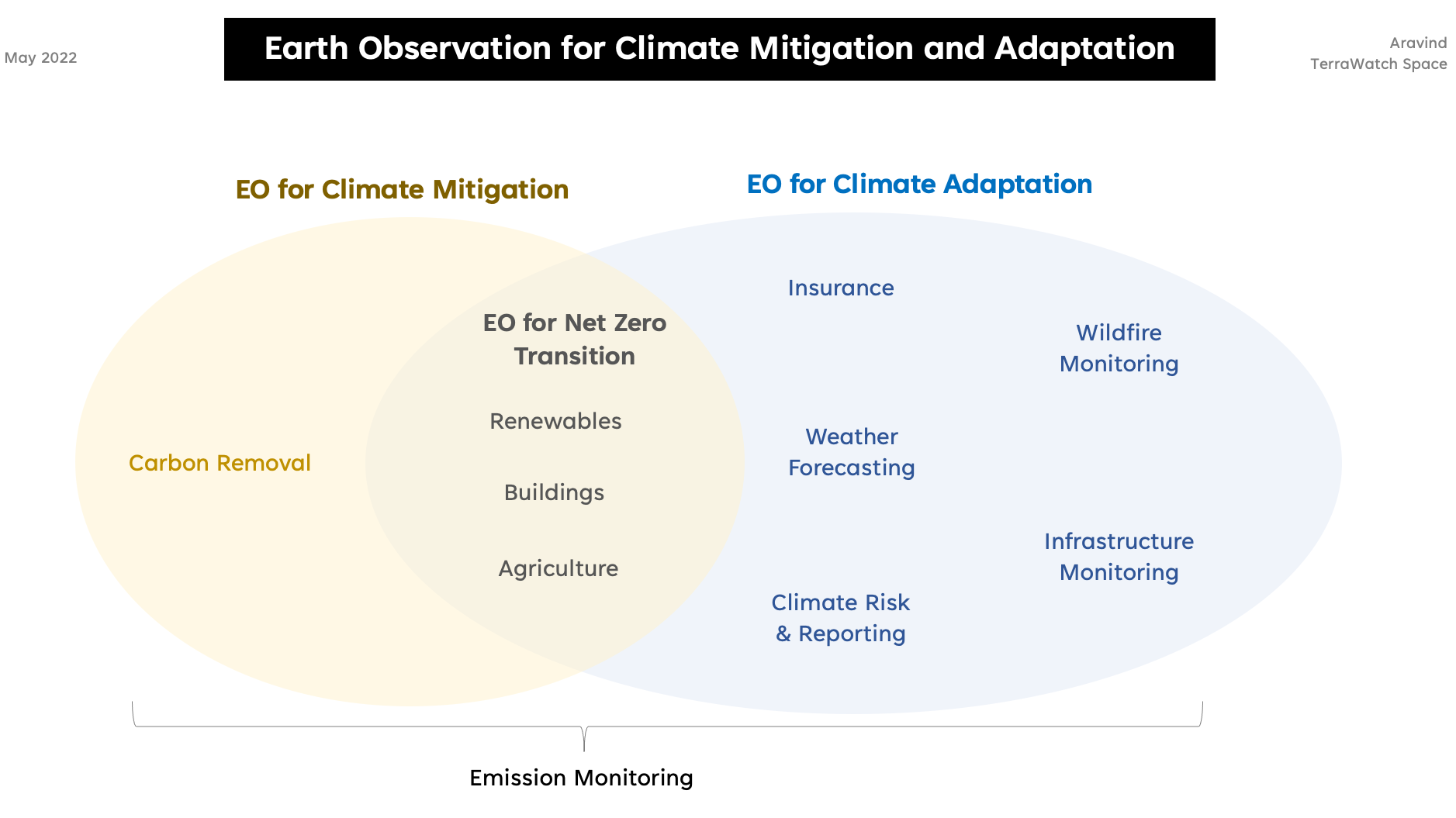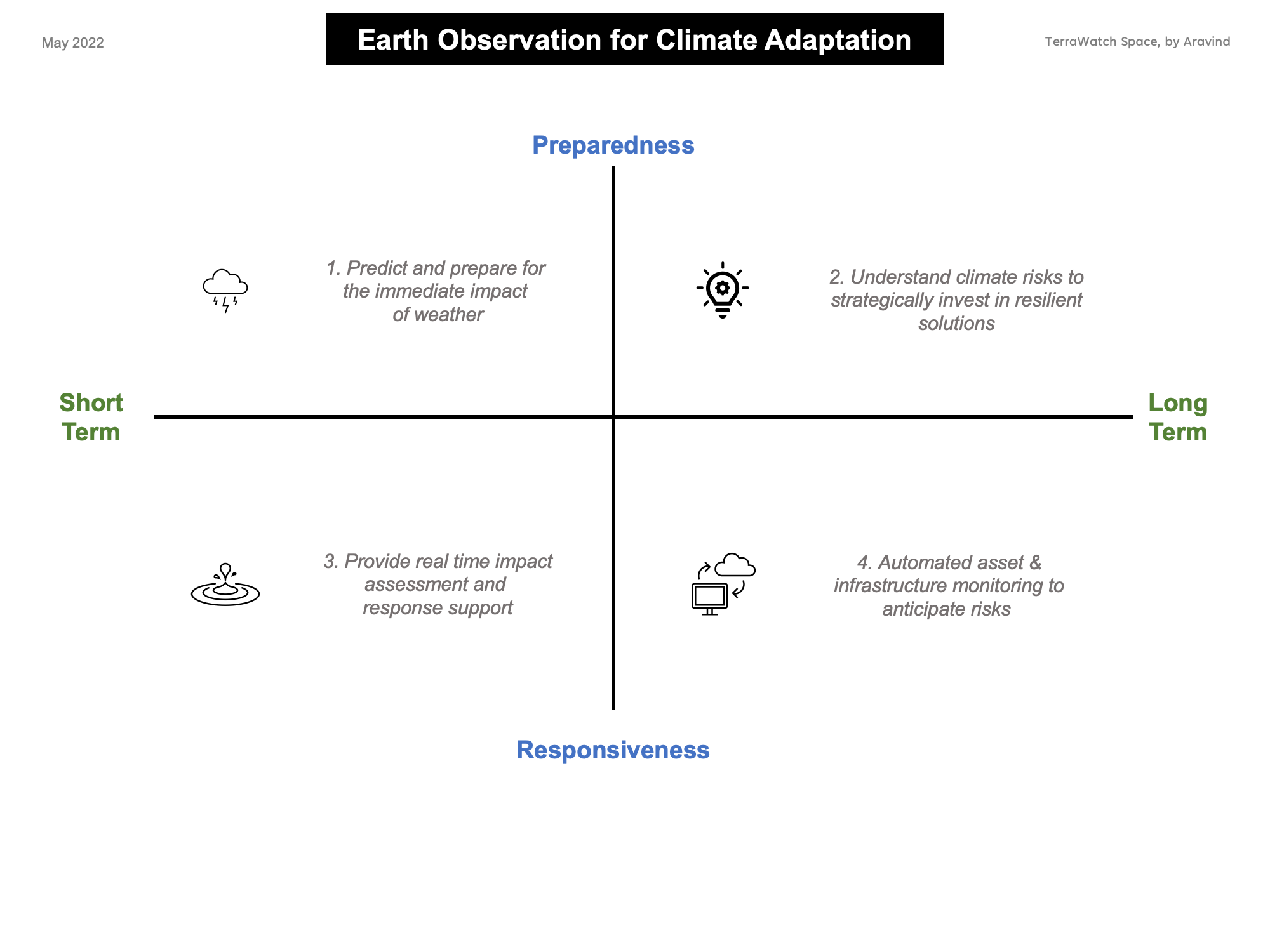Before we start, a special shoutout to the folks at ClimateTechVC, the best newsletter around for all things climate. I worked with them last year for this piece, and that’s really how my journey into understanding the climate tech market began!
Context
It goes without saying that Earth observation is something I am really passionate about. Given all its applications for climate and my interest in the climate tech ecosystem, it was going to be a matter of time before I write about the intersection of these two topics. This has been in the making for quite some time, but I think I am finally ready it publish it.
But, first things first …
It is important to acknowledge that observing the planet from space is not new. We have been observing the planet from space starting from the very first satellite humans launched - Sputnik 1, which collected some data about the upper atmosphere. NASA, ESA and space agencies around the world have launched hundreds of Earth observing satellites that have revolutionised our understanding of the planet.
How?
There are different frameworks and methodologies to understand the kind of climate-focused data we acquire from satellites, in combination with aerial and in-situ sensors. The most common one (easiest to understand) is Essential Climate Variables or ECVs, which include 54 groups of datasets to understand and predict the evolution of climate across land, air and oceans, put together by the Global Climate Observing System (GCOS) - a consortium of global organisations.

Want to learn more?
Then, I totally recommend browsing through the GCOS website to understand the variables and the World Meteorological Organization’s (WMO) OSCAR database to familiarise yourself with all the past, present and planned Earth observing satellites and the sensors. There are also online courses like this one and this one - both from ESA, reports like the State of Climate from the WMO and resources from the ESA Climate Office to get more context on climate change and the role of satellites.
In this piece, I want to dive into the rapidly growing commercial Earth observation market for climate. Let’s dive in!
Optional Pre-Read
If you are new to the wonderfully weird world of Earth observation, then I would recommend you start with the piece below, which I wrote about a year ago. It is a tad obsolete, but it should give you an introduction into this very fragmented and rapidly growing ecosystem.
The Earth Observation for Climate Landscape
Partially derived from my understanding of the Earth observation industry, I classify the Earth observation for climate landscape into three major segments: Climate Data, Climate Solutions and Climate Applications.

Climate Data: The Data Providers
This is the segment that is usually associated with the space industry - simply because it includes everything from designing the sensor, building the satellites, launching them and getting them to be operational. Some of these companies are vertically integrated, while some of these will certainly not be - thanks to the emerging space-as-a-service business models, that allow companies to essentially “outsource space.” And then there are the sensors - each with their own characteristics and applications relevant for climate. I have been working in EO for the last 6 years and coming from a non-remote sensing background, I will not stop learning about the different type of sensors. I made an attempt to map the companies and the sensors they are launching in one of my earlier pieces - and I will do so once more later this year. Stay tuned!
The "Climate Data” segment is organised into two sub segments - Multi-Vertical Data and Vertical-Specific Data. This classification is inspired from the emerging trend of “verticalization” I have written about before.
Verticalization is the strategy to focus on developing capabilities to solve a specific problem within a specific vertical as opposed to offering products for solving problems across industries and use cases.
Some companies are acquiring data from satellites that can be used for developing climate applications across industries while there are those that are focused on acquiring data for use within a specific climate application - emissions, weather, wildfires etc. I believe both horizontal EO companies and verticalised EO companies have a role to play - essentially a combination of multi-purpose EO data, combined with vertical-specific EO data to create scalable climate applications.
Climate Solutions: The Decision Enablers
This segment includes companies that create tools to empower the end-users to create their own climate applications - either through Marketplaces & Platforms or Vertical Agnostic Analytics.
- Marketplaces & Platforms are essentially aggregators of various types of EO data that can be used to build climate applications or simply, to just visualise satellite imagery - sometimes, that is all we need to understand climate change!
- Vertical Agnostic Analytics are companies that work on converting EO data into usable information, often that can be applied across use cases - for instance, to map floods or monitoring emissions, both of which can impact many verticals.
The Climate Solutions play a significant role in bridging the gap between availability of data and the creation of decision-support applications. Several of the existing Climate Applications use some form of a Climate Solution to make sense of the Climate Data.
Climate Applications: The Insight Engines
Here is where it becomes interesting - not just because it becomes incredibly hard to track down companies that are building climate-related applications powered by EO data, but also because of the sheer possibility of all the potential applications of EO data - especially when data from satellites is combined with aerial and in-situ sensors. Some applications such as weather forecasting and parametric insurance are already quite mainstream, whereas some including carbon monitoring (recommend this piece from BeZero if you are into EO for carbon monitoring) and emission reporting are just starting out. If you are a climate investor or just simply a climate enthusiast, like me, this is the segment of the market to watch out for. We have a lot of problems to solve, and we don’t have any clear winners - what more to ask for?!
Making Sense of the Earth Observation for Climate Market
Let’s be honest - the infographic above is pretty crowded. It took me quite a lot of time to put it together and make it readable. There must be an easy way - no, not for arranging logos on a slide, but for understanding the EO for climate tech market. In the figure above, I mostly tried to order the companies by vertical/use case, the classic way. It makes some sense, but I don’t think it’s the best way. Yes, it might work for an investor doing due diligence or an industry analyst doing some research. But, it might not be the best way to go deeper into understanding the applications of EO for climate and also perhaps to figure out the gaps. Therefore, I decided to try and find a framework to position Earth observation companies working on climate - thankfully it was not hard and I just hard to at look at the reality of climate change.
Earth Observation for Climate Mitigation and Adaptation
As the name suggests, climate mitigation focuses on developing tools and technologies to mitigate climate change, fundamentally by transitioning into net zero while climate adaptation focuses on developing tools and technologies to adapt to the reality of climate change. As you might have guessed, EO has a role to play across the mitigation - transition - adaptation spectrum, although, based on my high-level assessment of the companies more on the adaptation side.
As I started positioning companies based on the reality of climate change i.e. mitigation - transition - adaptation, it became clear to me that the market was actually not that crowded. I will leave it to you to position companies you might know within this spectrum and understand where the gaps might be.

Earth Observation for Climate Adaptation
As I was going through my exercise positioning companies within the climate spectrum, as shown above, one thing became clear to me - “EO for Climate Adaptation” is certainly a complex market to comprehend. It felt like several companies I looked at was working on the same type of application - at least from their websites (I blame common buzzwords - intelligence, risk, insights etc.). Once again, I knew there should be a better way to understand this fast-growing segment of the Earth observation industry. So, I came up with four categories of EO Climate Adaptation companies - classified based on Impact and Timeframe.
Impact - Preparedness vs Responsiveness: Is Earth observation applied for preparing for the impacts of climate change or for responding to the impacts of climate change?
Timeframe - Short Term vs Long Term: Is Earth observation used to build tools for the next few days and weeks or for the next few years and decades?

The above framework provided me four categories of companies, as seen from the four quadrants of the figure above, including:
- Those that work on predicting and preparing for the immediate impact of weather impacting several industries at once —> Short Term Preparedness
- Those that work on understanding climate risks for assets, infrastructure and people in the not too distant future —> Long Term Preparedness
- Those that provide real-time impact assessment and disaster support to respond to ongoing climate change —> Short Term Responsiveness
- Those that enable automated monitoring of assets and infrastructure in order to respond efficiently by anticipating risks —> Long Term Responsiveness
Once again, I will leave it to you to position companies from the infographic across these four categories - it is a fun exercise to try when you learn of a new climate tech company that is leveraging EO data.
If you enjoyed this, please share. Sometimes, distribution is more important than content.
Final Note
My motivation to write this piece and put the infographic together was purely curiosity, at least at this point. I had not come across any comprehensive resource that took a global view of the impact of EO for climate, especially from a commercial standpoint (if you know, please share). As cliched as it sounds, climate change is the most important problem of our times and I feel grateful to be part of an industry that has all the potential in the world to enable mitigation, transition and adaptation.
Please feel free to use the infographic with proper credits. And, do send me your thoughts and feedback. I am sure this will be the first of many editions to come.
Thanks for reading! Subscribe for free to receive new posts and support my work.
Cheers,
Aravind







